#gigantopithecus
Explore tagged Tumblr posts
Text


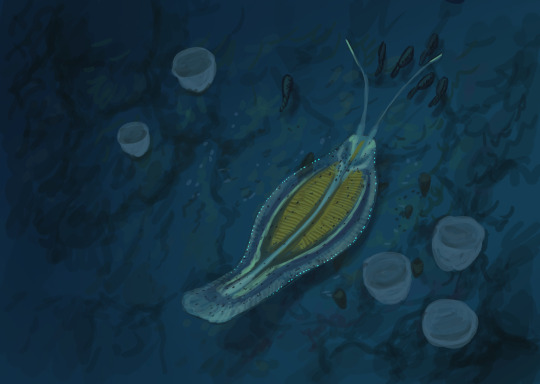
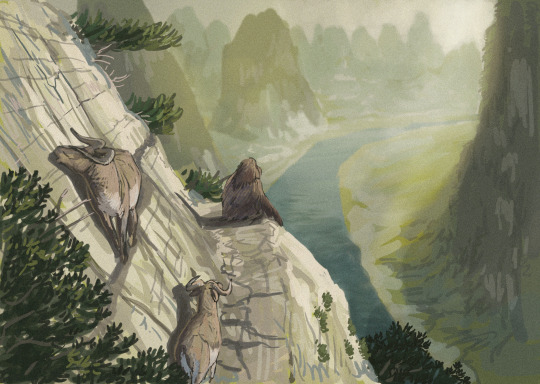
Results from the #paleostream
Entelognathus, Stenokranio, Timorebestia and Megalovis (with one big ape as well).
#sciart#paleoart#paleostream#palaeoblr#fish#placoderm#amphibian#stenokranio#pleistocene#goat#sketch#temnospondyl#arrow worm#gigantopithecus
1K notes
·
View notes
Text

Gigantopithecus
#Gigantopithecus#macaque#ape#monkey#primate#paleoart#paleoblr#pleistocene#forest#watercolour#art#artblr#now i noticed that i dated this as -24#were a month into -25 and i still havent gotten used to writing the correct year smh
301 notes
·
View notes
Text




Flocking 5/10/24 -- Maiasaura + Sigilmassasaurus + Boreaspis + Gigantopithecus
#paleostream#paleoblr#dinosaurs#maiasaura#paleoart#sigilmassasaurus#gigantopithecus#boreaspis#procreate#digital
421 notes
·
View notes
Text

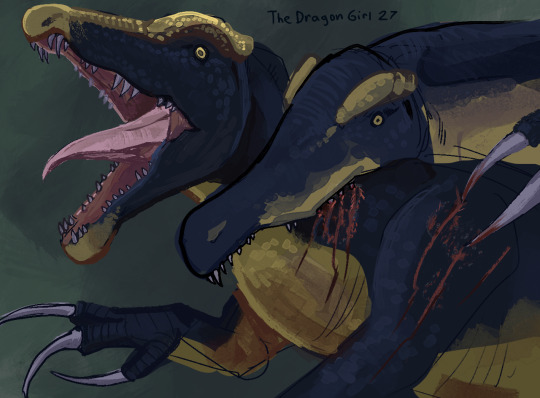
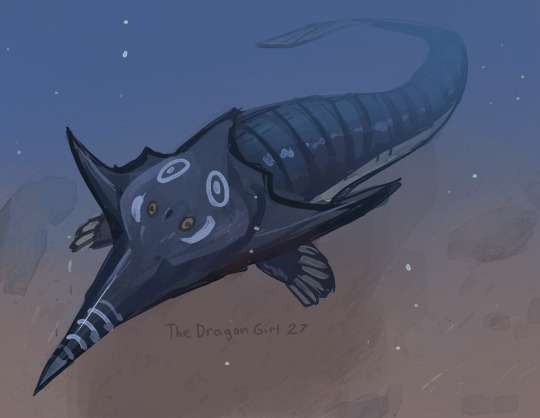
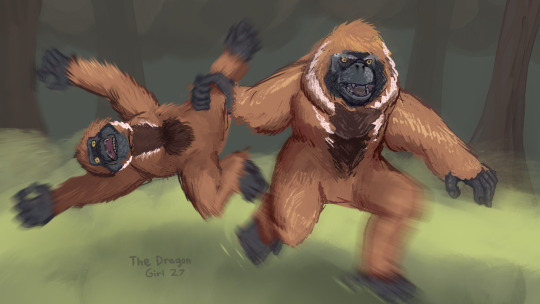
Flocking doodles
Maiasaura watching over her hatchlings
Sigilmassasaurus fighting for territory
Boreaspis swimmin round
Gigantopithecus yeeting another Gigantopithecus to assert dominance
#paleoart#paleostream#dinosaur#hadrosaur#Maiasaura#Sigilmassasaurus#spinosaurus#theropod#Boreaspis#fish#Gigantopithecus#primates#mammal#paleozoic#mesozoic#cenozoic#dragon draws creatures#yes the Gigantopithecus is based on the image of a gorilla yeeting another gorilla#fun fact Gigantopithecus was my suggestion for what to draw mostly because i wanted to draw a funny monkee and it won the vote lol#so everyone who complained about having to draw a monkee has me to blame#and also everyone else who voted for it lol#also while drawing it i played donkey kong music in the background cuz whynot#and i descovered the secret emotion that is drawing a monkee with jungle hijinks playing in the background#would reccomend
366 notes
·
View notes
Text
Paleostream 11/05/2024
here are today's #Paleostream sketches!!!
today we drew Maiasaura, Sigilmassasaurus, Boreaspis, and Gigantopithecus
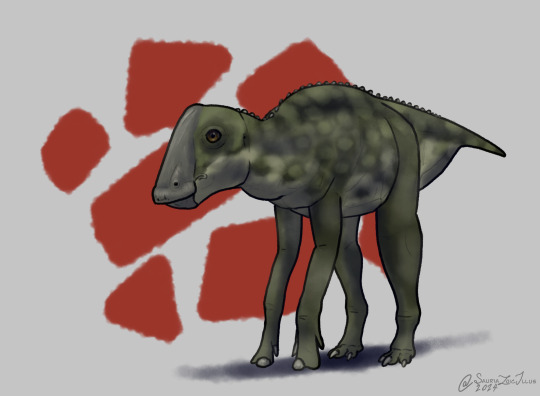
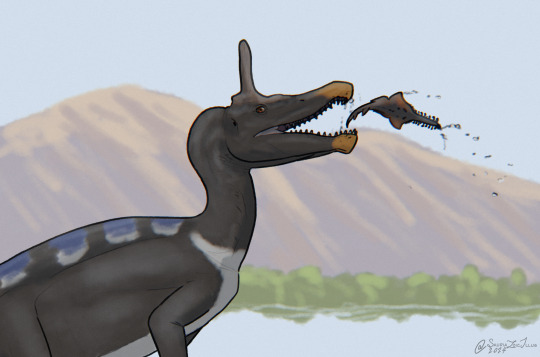
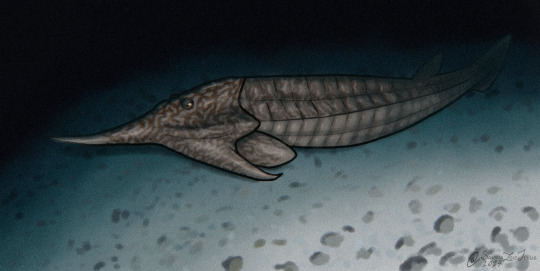

#Paleostream#paleoart#paleontology#digital art#artists on tumblr#digital artwork#palaeoart#digital illustration#sciart#id in alt text#dinosaur#dinosaur art#baby dinosaurs#jawless fish#fish art#extinct fish art#primates#ape#monkey art#Maiasaura#Sigilmassasaurus#Boreaspis#Gigantopithecus
176 notes
·
View notes
Text

Flocking Together
Maiasaura
Sigilmassasaurus
Boreaspis
Gigantopithecus
#paleoart#prehistory#paleostream#maiasaura#sigilmassasaurus#boreaspis#gigantopithecus#palaeoblr#made with krita
79 notes
·
View notes
Text

Joe Chiodo Conan cover for Marvel, 1983.
14 notes
·
View notes
Text
Gigantopithecus and Orangutan

13 notes
·
View notes
Text
Spec Evo - Wood Apes
Sasquatch (Gigantopithecus sylvaticus)
Evolutionary Origins
Sasquatch, classified within the Ponginae subfamily, is a surviving descendant of Gigantopithecus blacki, an extinct giant primate that once thrived across Pleistocene Asia. Fossil evidence suggests G. blacki was an herbivorous, forest-dwelling ape, but climate shifts and human expansion likely forced a portion of its population to migrate, adapting over millennia to new ecosystems across North America. Unlike its arboreal relatives, Sasquatch underwent terrestrial gigantism, evolving enhanced bipedal locomotion to navigate dense forests efficiently while retaining strong upper-body musculature suited for climbing and foraging.
Physical Characteristics
Sasquatch stands between 8 to 12 feet tall and weighs over 600 lbs, with a massive, barrel-chested torso covered in thick fur ranging from deep auburn to dark brown or black—an adaptation for insulating against cold climates. Its dermal ridges, observed in footprints, indicate a digitigrade walking posture, reducing noise during movement and aiding stealth. Compared to modern apes, its cranial capacity is significantly larger, suggesting advanced problem-solving abilities and environmental awareness. The mandibles and dentition closely resemble those of Gigantopithecus, with broad molars adapted for grinding fibrous plant matter.
Its skin pigmentation is melanin-rich, allowing mild infrared absorption, a trait observed in some nocturnal mammals for heat regulation. Additionally, Sasquatch exhibits countershading camouflage, where its underside is lighter than its back, reducing visual contrast and aiding concealment in shadowed environments.
Locomotion and Dexterity
Though primarily bipedal, Sasquatch retains semi-quadrupedal flexibility, using its arms for stability when traversing uneven terrain. Its achilles tendon structure suggests explosive bursts of speed when necessary, a trait common in terrestrial primates such as baboons. The prehensile hands have long, dexterous fingers with toughened pads, enabling fine manipulation of objects. Unlike orangutans, whose hand morphology favors grasping branches, Sasquatch exhibits ground-adapted knuckle reinforcement, supporting weight distribution over long distances.
Sensory Adaptations
Sasquatches have exceptional low-light vision, akin to that of nocturnal predators, aided by a tapetum lucidum—a reflective layer behind the retina that enhances night vision. This adaptation allows it to operate efficiently during dawn and dusk, minimizing encounters with human populations.
Auditory capabilities include infrasound communication, a trait found in elephants and tigers, which enables long-distance vocalizations undetectable to human ears. Sasquatches are known to emit deep-chested vocalizations, engage in wood-knocking, and produce whistle-like calls to signal territory or coordinate movement.
Its olfactory senses are highly developed, with Jacobson's organ—an auxiliary sensory system found in some mammals—allowing it to detect pheromonal cues for identifying prey, territorial markings, or environmental changes.
Diet and Foraging Behavior
Sasquatches are opportunistic omnivores, consuming a diet of roots, tubers, fungi, berries, and occasional protein sources such as small mammals or scavenged carcasses. Its powerful jaw muscles allow it to process tough plant fibers, mirroring the dietary adaptations of Gigantopithecus blacki. Unlike obligate carnivores, Sasquatch relies on fermentation in the gut, similar to gorillas, enabling digestion of dense vegetation.
Sasquatch exhibits seasonal dietary shifts, consuming higher-caloric foods in preparation for colder months, similar to bear hibernation patterns. Additionally, they have rudimentary food storage behaviors, including stashing edible material in natural crevices or buried caches.
Social Structure and Territoriality
Unlike other great apes, which display clear troop hierarchies, Sasquatch usually exhibit solitary or small-clan behavior, maintaining vast territorial ranges to avoid competition. Evidence suggests regional vocal dialects, indicating structured communication between individuals occupying adjacent ranges.
Sasquatch exhibits environmental engineering, demonstrated by reports of constructed lean-to shelters, woven branch structures, and strategically placed rock formations for marking territory or guiding navigation. Their ability to manipulate objects implies a rudimentary understanding of tool usage, though primarily for environmental modification rather than advanced crafting.
Ecological Role
As a keystone species, Sasquatch influences forest ecosystems by dispersing seeds through its diet, contributing to vegetative regeneration. Its presence as an apex herbivore helps regulate plant overgrowth, preventing habitat imbalance. Potential interactions with wildlife include avoidance of large predators, using strategic movement to minimize conflicts with bears, mountain lions, or wolves.
Although elusive, Sasquatch sightings have occurred consistently over centuries, aligning with indigenous folklore describing forest-dwelling guardians.
Yeti (Gigantopithecus himalayensis)
Evolutionary Origins
The Yeti, (Gigantopithecus himalayensis), is a high-altitude offshoot of Gigantopithecus blacki, adapted for survival in the extreme conditions of the Himalayas. Fossil evidence indicates that G. blacki thrived in tropical environments, but climate shifts may have forced a population to migrate northward, gradually evolving traits suited for alpine ecosystems. Unlike Sasquatch, which is adapted for temperate forests, the Yeti exhibits cold-weather gigantism, a phenomenon seen in large mammals like bison and bears, where increased body mass aids thermoregulation.
Physical Characteristics
The Yeti stands between 7 to 10 feet tall, with an extremely robust frame and thick fur ranging from white to gray, providing camouflage against snow-covered landscapes. Its double-layered coat is similar to that of Tibetan blue bears, consisting of dense underfur beneath long, coarse guard hairs. Unlike orangutans, which have shorter limbs for climbing, the Yeti’s longer legs allow it optimized bipedal movement across snow. Large plantigrade feet distribute weight evenly to prevent sinking, akin to adaptations in snowshoe hares and lynxes.
Additionally, it possesses enlarged nasal passages, increasing oxygen intake at high altitudes, and hemoglobin adaptations similar to Tibetan humans, allowing for efficient blood oxygen transport in lower atmospheric pressure.
Diet and Behavior
The Yeti is a facultative omnivore, consuming lichen, roots, winter berries, and opportunistic protein sources such as carrion or small mammals. It even exhibits seasonal hibernation behaviors, reducing metabolic activity during extreme Himalayan winters. Unlike Sasquatch, which prefers dense forests, the Yeti thrives in high-altitude rocky terrain, relying on stealth and environmental awareness to avoid predators such as snow leopards.
Its territorial behavior includes vocalizations such as low-frequency growls, rumbling infrasound, and rhythmic rock-knocking, similar to known primate communication methods. Unlike fully social great apes, the Yeti exhibits semi-solitary behavior, maintaining small familial units scattered across vast territories.
Orang Pendek (Minopongo sumatranus)
Evolutionary Origins
Orang Pendek (Minopongo sumatranus), meaning “short person” in Indonesian, is a species of dwarf pongine. Unlike its gigantopithecine relatives, Orang Pendek represents a miniaturized adaptation to dense, lowland rainforests. This species evolved from early Pongo ancestors, adapting for ground-level agility and terrestrial foraging, distinguishing it from modern arboreal orangutans.
Its small stature—between 3 to 5 feet tall—reduces metabolic demands, allowing efficient survival in resource-scarce environments. Theories suggest Orang Pendek may exhibit convergent traits with extinct hominin species like Homo floresiensis, another small-bodied primate that adapted for tropical island survival.
Physical Characteristics
Orang Pendek is covered in short, coarse reddish-brown fur, closely resembling the coat of modern orangutans. Unlike its arboreal relatives, it exhibits strong, compact limb musculature, suited for rapid movement through jungle undergrowth. Its plantigrade walking posture allows for stealth and efficiency in navigating dense foliage. Additionally, its hands and feet remain highly dexterous, enabling the use of tools for foraging.
Compared to Sasquatch and Yeti, Orang Pendek has smaller, rounded molars, indicative of a fruit-heavy diet, supplemented with roots, insects, and small vertebrates. Its jaw structure suggests powerful bite force, allowing it to process hard nuts and fibrous plants.
Behavior and Ecology
Orang Pendek exhibits solitary and small-group behavior, mirroring the reclusive nature of orangutans. Unlike the Yeti or Sasquatch, which thrive in colder regions, Orang Pendek is strictly tropical, relying on dense rainforest cover for concealment. It exhibits intelligent foraging strategies, such as using rocks or sticks to extract insects, resembling rudimentary tool use seen in wild orangutans.
Its cryptic nature and alleged ability to mimic forest sounds may serve as defense mechanisms against predators such as clouded leopards and sun bears. While some legends describe Orang Pendek as a near-human entity, its placement in Ponginae suggests it is a specialized primate rather than a hominin-relative.
Yeren (Gigantopithecus sinensis)
Evolutionary Origins
The Yeren (Gigantopithecus sinensis), or "Wild Man" of China, is an offshoot of G. blacki that survived in the dense subtropical forests of central and southern China. Unlike Sasquatch and Yeti, the Yeren exhibits arboreal adaptations, suggesting it retained some tree-climbing capabilities while incorporating more terrestrial behaviors over time. It likely diverged from Gigantopithecus populations that migrated eastward, evolving traits suited for warmer, humid environments.
Physical Characteristics
The Yeren stands between 6 to 9 feet tall, with reddish or dark brown fur, reflecting similarities to modern orangutans (Pongo spp.). Unlike fully terrestrial primates, Yeren retains curved fingers and powerful gripping strength, allowing it to navigate canopies or scale rock faces when necessary. Its limb proportions suggest semi-bipedal locomotion, switching between upright walking and quadrupedal movement depending on terrain.
Its facial structure exhibits pronounced brow ridges, deep-set eyes, and a sloping forehead, similar to fossil evidence of Gigantopithecus. Unlike Sasquatch, which thrives in temperate forests, Yeren's lighter skeletal frame allows for greater agility in thick jungle environments.
Diet and Behavior
Yeren is a frugivorous omnivore, consuming fruit, nuts, small vertebrates, and honey. Reports suggest tool-using behaviors, such as using rocks to crack nuts or sticks to extract insects, indicating primitive problem-solving abilities. Unlike Sasquatch, which may exhibit nocturnal habits, Yeren is diurnal, maintaining activity during daylight hours while avoiding dense human settlements.
Yeren is territorial yet passive, avoiding direct confrontation and relying on stealth and strategic retreat patterns. Vocalizations include low growls, hoots, and wood-knocking, similar to observed orangutan behavior.
Almas (Australopongo caucasicus)
Evolutionary Origins
The Almas (Australopongo caucasicus), reported in Central Asia and the Caucasus region, is a cold-adapted pongine that evolved in high-altitude, temperate regions. Compared to its relatives, Almas exhibits shorter fur, reduced body size, and enhanced endurance suited for mountainous terrain. Its lineage may trace back to ancient hominid-like pongines that migrated westward from Southeast Asia, adapting to a mixed-woodland and grassland ecosystem.
Physical Characteristics
Almas is shorter than Yeti or Sasquatch, standing between 5 to 7 feet tall, with stocky, muscular proportions optimized for climbing and navigating steep environments. Unlike the taller Gigantopithecus descendants, Almas has broad feet and shorter limbs, indicating enhanced power and stability over agility.
Its facial structure is closer to orangutans, retaining a sloping forehead and large jaw structure, but exhibiting forward-set eyes, implying enhanced depth perception for tracking movement in open terrain. Fur coloration ranges from grayish-brown to tawny, blending with rocky landscapes.
Diet and Behavior
Almas is a foraging omnivore, subsisting on roots, fungi, tubers, insects, and occasional protein sources. Unlike the tree-dependent Yeren, Almas exhibit burrowing behaviors, utilizing caves or rock crevices for shelter. The wide territorial range of Almas suggests a nomadic lifestyle, migrating seasonally in response to food availability.
Reports suggest rudimentary communication, including soft vocalizations, rock placements, and gestural behaviors, potentially resembling early hominid communication styles.
Yowie (Gigantopithecus australis)
Evolutionary Origins
The Yowie (Gigantopithecus australis), associated with Australia, represents a unique pongine adaptation to arid environments. Unlike its forest-dwelling relatives, the Yowie evolved traits suited for survival in savanna, scrubland, and eucalyptus forests, adapting kangaroo-like movement efficiency to cover large distances.
Fossil evidence suggests that Gigantopithecus never reached Australia, but land bridge migration during prehistoric climate shifts could have introduced proto-pongine species, which then adapted to Australia’s harsh and unpredictable climate.
Physical Characteristics
The Yowie stands between 6 to 10 feet tall, with dark brown or black fur, similar to marsupial megafauna such as wombats or koalas. Compared to Sasquatch, Yowie exhibits leaner muscle structure, longer limbs, and reduced bulk, allowing it to move more efficiently across open terrain.
Unlike other pongines, the Yowie’s foot structure resembles kangaroo-like digitigrade adaptation, allowing for long-distance travel and rapid acceleration. Additionally, its facial morphology exhibits elongated jaw structures, enabling efficient water conservation and adaptation to drought conditions.
Diet and Behavior
The Yowie is a dry-climate omnivore, consuming roots, eucalyptus leaves, insects, and carrion. Unlike Sasquatch, which maintains cold-weather adaptations, Yowie developed heat-regulating physiological features, including sparse fur density and sweat gland adaptations similar to desert-adapted mammals.
Reports suggest intelligent problem-solving, with terrain memory, trail-marking behaviors, and complex evasive tactics when encountering threats. Unlike territorial Sasquatch, Yowie exhibits wide-range nomadism, constantly shifting its habitat in response to seasonal changes.
#art#drawing#illustration#sketch#artwork#artist#creature#creature art#creature drawing#writing#writers on tumblr#creative writing#spec bio#spec evo#speculative biology#speculative zoology#speculative evolution#wood ape#cryptids#cryptid#bigfoot#sasquatch#cryptozoology#cryptozoologicon#yeti#yeren#orang pendek#almas#yowie#gigantopithecus
7 notes
·
View notes
Text

More sketches of the Pleistocene Megafauna, from top to bottom: Aenocyon dirus, Arctodus simus, Gigantopithecus blacki, Bison latifrons and Panthera spelaea
#paleoart#paleontology#pleistocenemegafauna#pleistocene#cenozoic life#cenozoology#cenozoic#gigantopithecus#bison latifrons#short faced bear#dire wolves#dire wolf#cave lion
54 notes
·
View notes
Text
From the last 2 Friday flocking Paleosteams.
Liopleurodon.
Homo Erectus, yes they are room mates.
Anchiornis mother and chick.
Marambionectes.
Maiasaura sunset.
Sigilmassasaurus taphonomy & shark's.
Boreaspis school.
Gigantopithecus jumping among rock garden's.
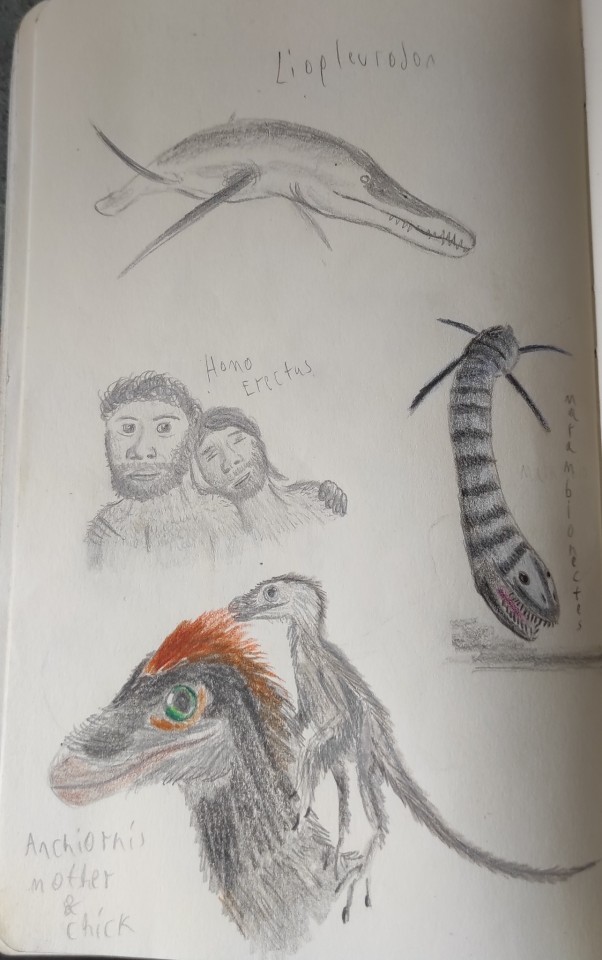
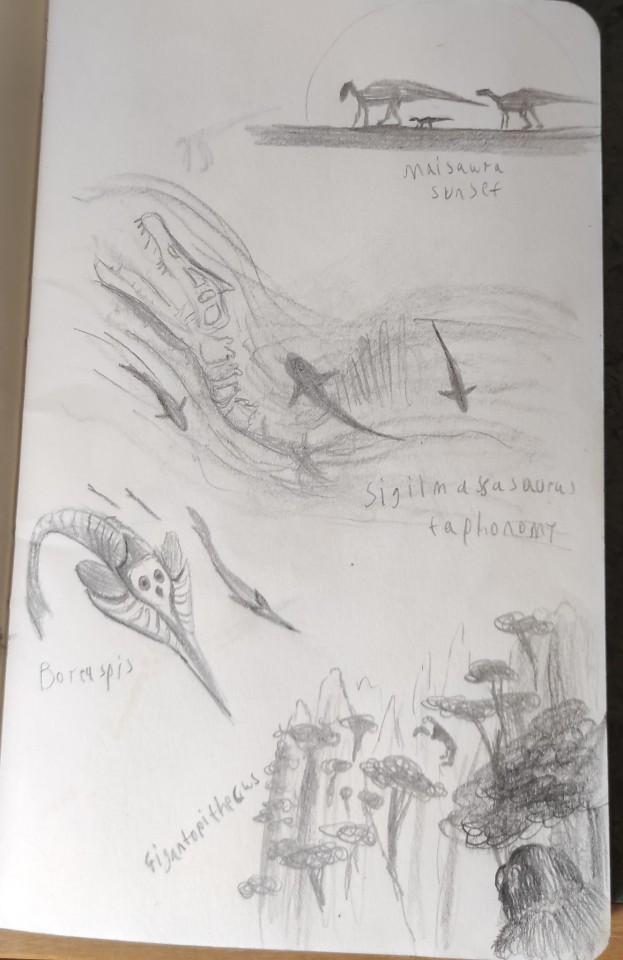
#paleoart#paleontology#dinosaurs#cretaceous#jurassic#liopleurodon#homo erectus#anchiornis#marambionectes#maiasaura#sigilmassasaurus#boreaspis#gigantopithecus#paleostream#taphonomy#extinct species#room mates
23 notes
·
View notes
Text

Here's my iteration of King Kong.
Design notes: my King Kong design is a mix of skull island and peter Jackson traits. I wanted him to look like an orangutan mix with a gorilla. I gave him bumps on his hands are bony knuckle studs covered in hardened skin, to protect his fingers while knuckle-walking and give him a nastier punch.
Alias: Kong, king of the apes
Size: 45 meters
Species: gigantic skull island yeti (peloropithecus rex)
Classification: homidae
Backstory:
A gigantic ape that resides in the jungles of the remote skull Island, living behind a huge wall constructed by the native humans. The natives gave the giant ape the "King Kong" ( after the demon god from skull island folklore) and worship him .from and frequently pray to him and prepare offerings of Farolacton juice.
Bio:
The the year 1953 King Kong was discovered by an expedition to Faro Island, which was sent there by Mr. Tako, marketing executive for Pacific Pharmaceutical, in order to find a legendary monster worshiped by the natives. The expedition only heard Kong's roar from the mountains, but saw the beast himself when he battled a Giant Octopus that attacked a village on the island. After chasing the octopus off, Kong began to drink jars of the Farolacton berry juice that the natives had prepared, and fell asleep. The expedition members had Kong tied to a raft and taken back to Japan to be used as publicity for the company, but their ship was stopped by the Japanese Coast Guard, who informed Tako that he would be liable for any damage caused by King Kong in Japan. Suddenly, Kong began to stir and try to break free of the raft. The crew members opened fire on the dynamite attached to the raft, causing it to explode. Kong emerged from the water unharmed, and swam to the Japanese mainland.
The confrontation with Godzilla:
Kong rampaged along the coastline until he encountered Godzilla in the wilderness. Kong tossed a boulder at Godzilla, who responded with a blast of his atomic breath, which singed Kong's fur and set much of the forest ablaze. Kong scratched his head and walked away in defeat.
Later, Kong arrived in Tokyo and easily passed the electrical barrier that had been used to repel Godzilla earlier, actually drawing strength from the electrical current. Kong smashed several buildings in his path and grabbed a train, and while looking inside was smitten with Fumiko Sakurai. Kong grabbed Fumiko and dropped the train, then climbed to the top of the National Diet Building. The JSDF surrounded the building and loaded rockets with a gas made from the Farolacton berry juice while playing a recording of the Faro Islanders' chant, hoping to lull Kong back to sleep. After a few minutes, Kong fell unconscious and slid off the building, allowing the JSDF to rescue Fumiko. The JSDF then formed a desperate plan: bring Kong to Mount Fuji so he can fight Godzilla and the two monsters will destroy each other. Kong was tied to several large balloons with indestructible metal wire and towed by helicopters to Mt. Fuji. Kong was dropped onto Godzilla, and the two titans resumed their battle. Godzilla again claimed the upper hand, eventually battering Kong into unconsciousness and razing him with his atomic breath. Luckily for Kong, a lightning storm passed overhead and Kong was struck by lightning, re-energizing him and surging an electrical current through his body. Kong grabbed Godzilla's tail, electrocuting him with his touch, and the battle raged on, this time with both combatants on equal footing.
The end of the monster?
The monsters fought across the Fuji wilderness until they reached Atami Castle, which they destroyed before tackling each other into the ocean below, causing an earthquake. After the tremors settled, Kong emerged from Sagami Bay with Godzilla nowhere in sight, and began swimming back to skull Island.
Abilities: strength, durability, electrical affinity
3 notes
·
View notes
Text
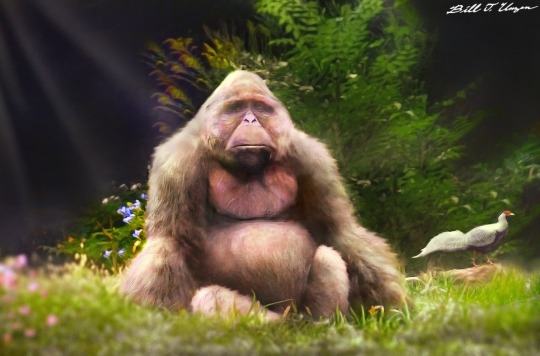
†Gigantopithecus blacki
Art credit: Orribec
Gigantopithecus is an extinct species famous as the largest ape ever known. However, not that much is known about it, since it’s only known from jaw and tooth fossils, so its appearance is largely speculative. What is known is that it lived in Chinese tropical forests from 2 million to 300,000 years ago, and ate plants, fruits, seeds, and probably small animals. It is estimated to have weighed anywhere from 440-660lbs (200-300kg), potentially much larger than gorillas. However size estimates are difficult with so few remains, and given the size sexual dimorphism present in many modern apes, there was probably a variety of different sizes between individuals.
#markhors-menagerie#primates#apes#great apes#animal facts#fun facts#animals#biology#palaeontology#prehistoric life#prehistoric animals#gigantopithecus
38 notes
·
View notes
Text
Cursed mythical creatures no.1: The Yeti
So you know how we used to reconstruct Gigantopithecus as an upright biped, which led to it being used as an explanation for the likes of the yeti and bigfoot. Nowadays, though, Gigantopithecus is reconstructed as basically an orange gorilla with the face of an orangutan. But that got me wondering...
What if the yeti actually was a gigantopithecus?

So here it is, my Yeti, in all its knuckle walking glory. I'm really proud of them, especially the male with his magnificent beard. My favourite thing about him is the falanges which form little horn like structures on top of his head, as a nod to several pop culture yeti interpretations.
Hope you guys like it! I might make cursed mythical creatures into a series if I have more ideas. Thanks, and hope you have a good day.
8 notes
·
View notes
Text

Tsusetanus
Altura: 180 metros (en 2 patas)
Longitud: 108 metros (en 4 patas)
Peso: 100,500 toneladas
Primer Avistamiento: Himalayas [Tierra: Teratoverso]
Controles: Tierra Control [Camuflaje, piel de acero, deslave artico] Energia Control [Contraataque potente, rayos oculares] A Agua Control [Permafrost]
Guarida: Himalayas [Tierra: Teratoverso] Ba Sing Se [Avatarverso]
Aspecto: Gigantopithecus
Aliados:
Humanos: Aang, Katara, Soka, Iroh, Zuko
Kaijus y otras bestias: Anguirus, Baragon, Mothra, Rodan, Godzilla
Enemigos:
Humanos: Ozai y Azula
Kaijus y otras bestias: King Ghidorah
2 notes
·
View notes
Text
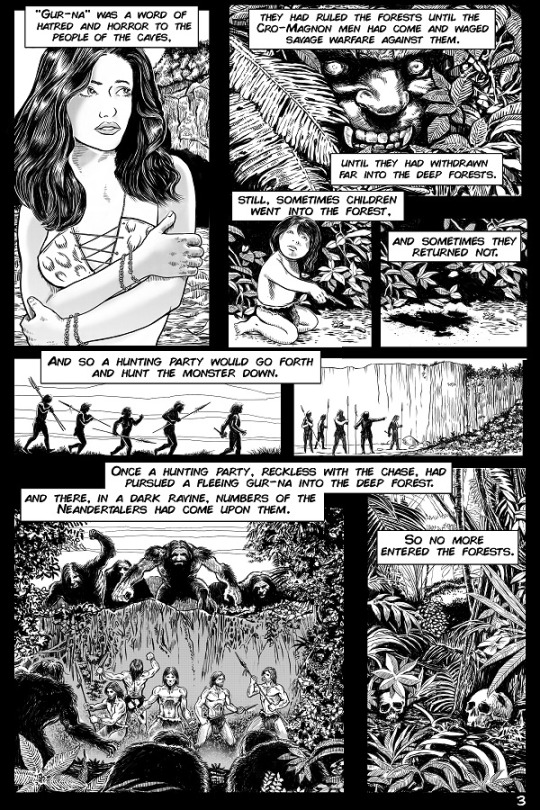



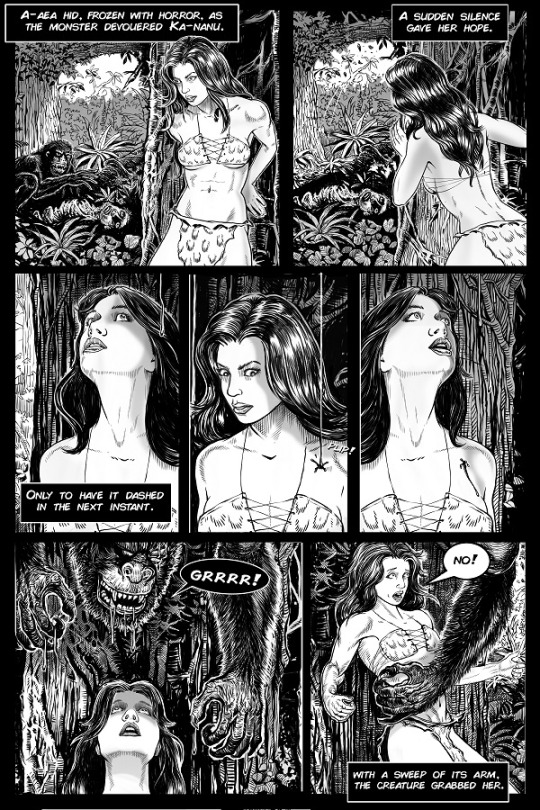


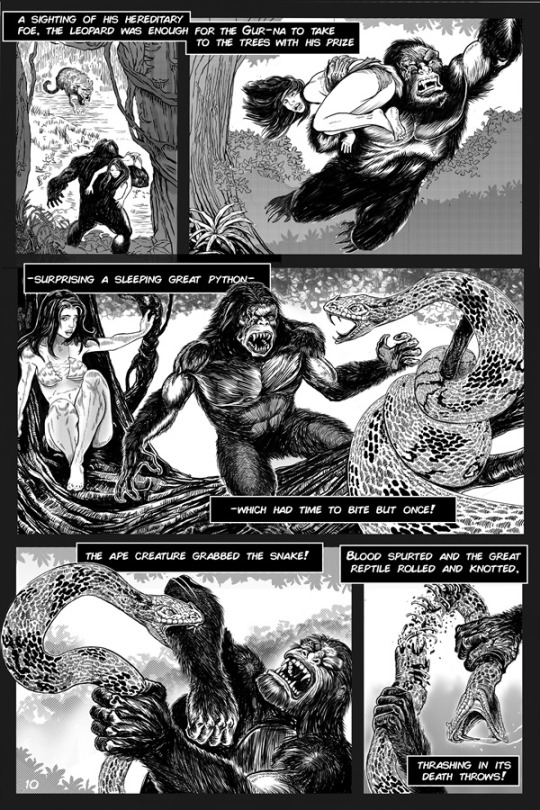
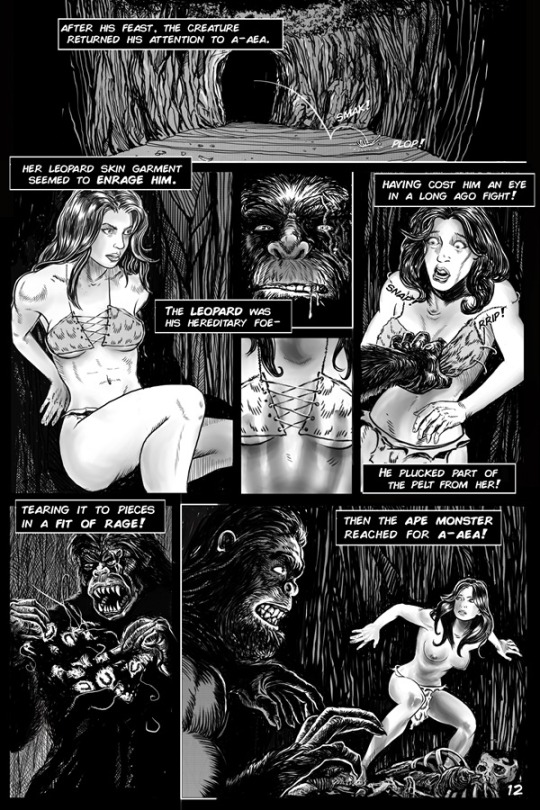
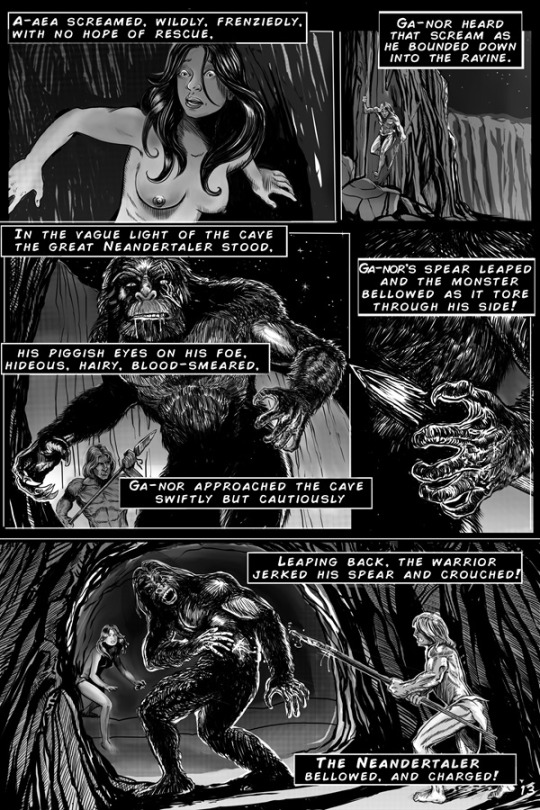
Pages 3-12 of Gary McClusky's adaptation of Robert E. Howard's first published story Spear and Fang (1925). Needless to say, Howard's portrayal of the neanderthal is a bit out of date (despite what Danny Vendramni would like to believe), but McClusky has faithfully reproduced it for the sake of the story. It honestly looks more like a Gigantopithecus to me, which is a better fit for the apparently tropical setting anyway.
#fantasy#comics#robert e howard#gary mcclusky#neanderthal#neanderthal predation theory#gigantopithecus
7 notes
·
View notes